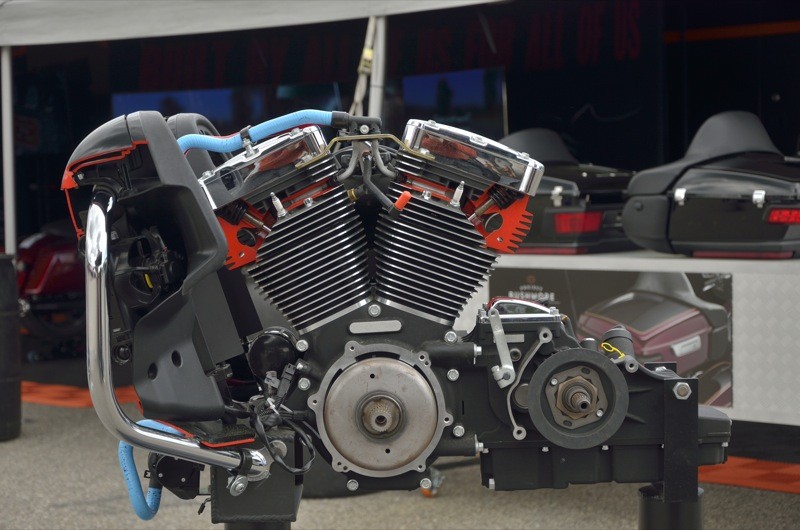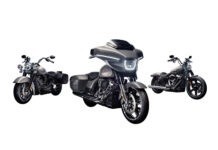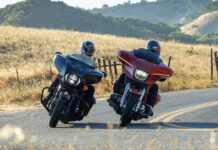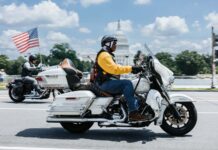Laconia, N.H., June 11–18—Just like the rest of us, Harley-Davidson is stuck between the die-hard ultra conservatives and the vocal liberals. On one hand, to alter the design of their iconic product is akin to violating the freedom to ride, while on the other extreme new riders are demanding features generally found on foreign bikes. Project RUSHMORE was unveiled in 2014 but the Harley-Davidson engineers did such a good design job that most people aren’t aware that their motorcycles have changed—a lot. At the New Hampshire Motor Speedway, the Milwaukee company set up a special trailer during Laconia Motorcycle Week to show prospective customers how much their bikes have evolved.
The sound system—complete with voice activation, 6.5” touch screen, and Bluetooth wireless connection—may be intuitive to young riders raised in the era of smartphones, but for the rest of us it requires a bit of practice to master. The GPS not only lets you know where you are, but allows one to download gpx files or create navigational routes directly on the bike’s screen. If that wasn’t enough, it even provides a warning when you’re low on fuel and gives directions to the nearest gas station.
Jukebox is simply a water-resistant storage compartment containing plug connections for thumb drives, iPods and iPhones. It will even charge your phone while you ride. Sirius radio is another standard feature, but there is a sound package ($4,300) that will transform your two wheels into a mobile concert hall.

Project Rushmore has resulted in over 100 changes to the company’s touring bikes. Some of these are relatively minor and some are huge. The liquid-cooled 103” engine debuted in 2014 and while the concept of using both air and liquid coolant isn’t new to motorcycles it certainly was long overdue for these large-displacement V-Twins. The fact that H-D managed to do this without changing the appearance of the touring bikes is essential to purists. Anti-lock integrated braking is another new, but long overdue feature. On a bike this heavy I consider such to be essential.
The Project RUSHMORE Experience tent was set up to introduce prospective customers to the changes in H-D touring machines. A 2011 and 2016 FLT Ultra were set up next to each other with a display that points out 34 new features found on the RUSHMORE bikes. Some, like new medallions and graphics, aren’t worth mentioning; others such as the Daymaker LED headlights and dual-float open rotors are extremely important.
In front of two large fans and three integrated curved LCD screens sits an Ultra Classic, front wheel chocked and rear on rollers. Running the video—I saw the Blue Ridge Parkway, Grand Tetons, and downtown Pittsburgh—people are able to simulate a ride while being presented with Project RUSHMORE features such as comparing standard headlight coverage to that of the new LED headlights. It’s not a simulator and I didn’t run off the road when refusing to slow down for corners—besides, the fixed front end wouldn’t countersteer—but the Project Jumpstart-like setup is an excellent sales tool.

Naturally there was a cutaway 103 c.i. dual-cooled engine displayed as well as the new one-hand catches for the side and top cases set against the former (i.e. very awkward) latches. A mockup fairing provided an opportunity to practice using the onboard computer system and a very large, interactive cell-phone display showed how people could log onto the Harley-Davidson website for instructions. Consider this to be the replacement for bulky paper operating manuals.
Three bikes were set up as display models to illustrate the optional equipment available for the RUSHMORE touring bikes. A Vengeance chrome package, $10,831 on the Road Glide and $10,400 on the Road King, and an Ultra Sound package—$4,300 on an Ultra—pushes the sticker price into the stratosphere, but that sound package was drawing the attention of a lot of people.
What the Project RUSHMORE Experience does is show people that, despite appearances, these are technologically advanced and very luxurious touring motorcycles. No, they’re not your grandpa’s Harley, nor your daddy’s, and I think that is a very good thing. Now I just have to figure how to come up with 30 grand.


















